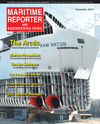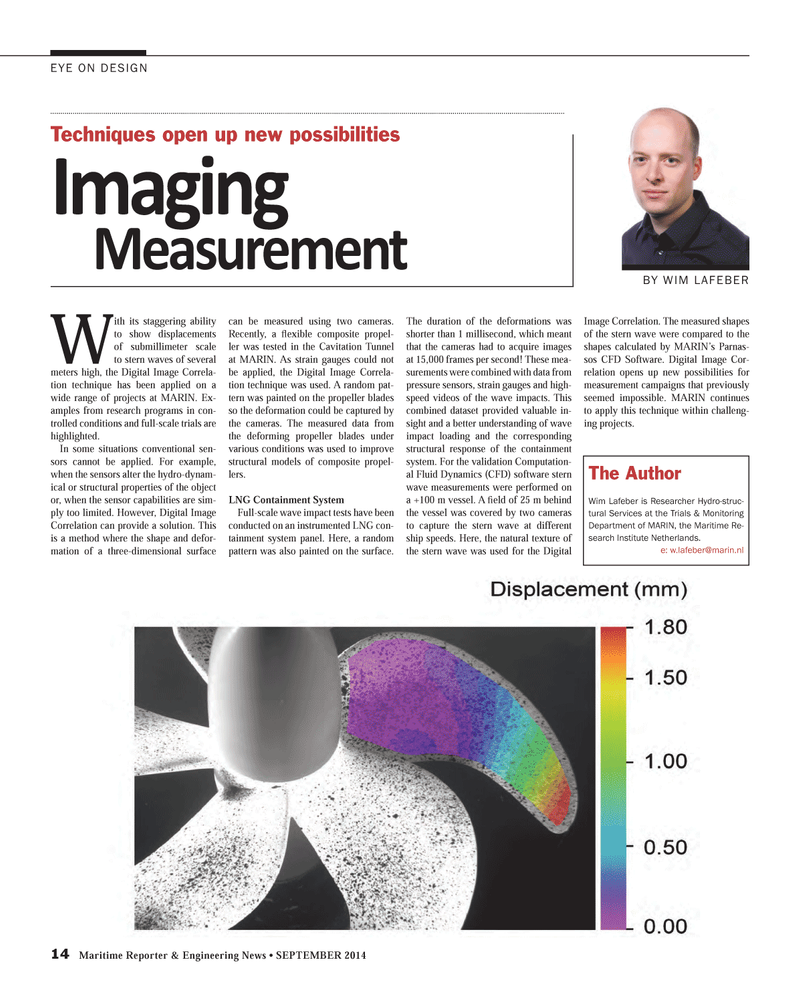
Page 14: of Maritime Reporter Magazine (September 2014)
Marine Propulsion Edition
Read this page in Pdf, Flash or Html5 edition of September 2014 Maritime Reporter Magazine
14 Maritime Reporter & Engineering News • SEPTEMBER 2014
EYE ON DESIGN
W ith its staggering ability to show displacements of submillimeter scale to stern waves of several meters high, the Digital Image Correla- tion technique has been applied on a wide range of projects at MARIN. Ex- amples from research programs in con- trolled conditions and full-scale trials are highlighted.
In some situations conventional sen- sors cannot be applied. For example, when the sensors alter the hydro-dynam- ical or structural properties of the object or, when the sensor capabilities are sim- ply too limited. However, Digital Image
Correlation can provide a solution. This is a method where the shape and defor- mation of a three-dimensional surface can be measured using two cameras.
Recently, a fl exible composite propel- ler was tested in the Cavitation Tunnel at MARIN. As strain gauges could not be applied, the Digital Image Correla- tion technique was used. A random pat- tern was painted on the propeller blades so the deformation could be captured by the cameras. The measured data from the deforming propeller blades under various conditions was used to improve structural models of composite propel- lers.
LNG Containment System
Full-scale wave impact tests have been conducted on an instrumented LNG con- tainment system panel. Here, a random pattern was also painted on the surface.
The duration of the deformations was shorter than 1 millisecond, which meant that the cameras had to acquire images at 15,000 frames per second! These mea- surements were combined with data from pressure sensors, strain gauges and high- speed videos of the wave impacts. This combined dataset provided valuable in- sight and a better understanding of wave impact loading and the corresponding structural response of the containment system. For the validation Computation- al Fluid Dynamics (CFD) software stern wave measurements were performed on a +100 m vessel. A fi eld of 25 m behind the vessel was covered by two cameras to capture the stern wave at different ship speeds. Here, the natural texture of the stern wave was used for the Digital
Image Correlation. The measured shapes of the stern wave were compared to the shapes calculated by MARIN’s Parnas- sos CFD Software. Digital Image Cor- relation opens up new possibilities for measurement campaigns that previously seemed impossible. MARIN continues to apply this technique within challeng- ing projects.
Imaging Measurement
Techniques open up new possibilities
BY WIM LAFEBER
The Author
Wim Lafeber is Researcher Hydro-struc- tural Services at the Trials & Monitoring
Department of MARIN, the Maritime Re- search Institute Netherlands. e: w.lafeber@marin.nl
MR #9 (10-17).indd 14 9/3/2014 11:10:33 AM

 13
13

 15
15
